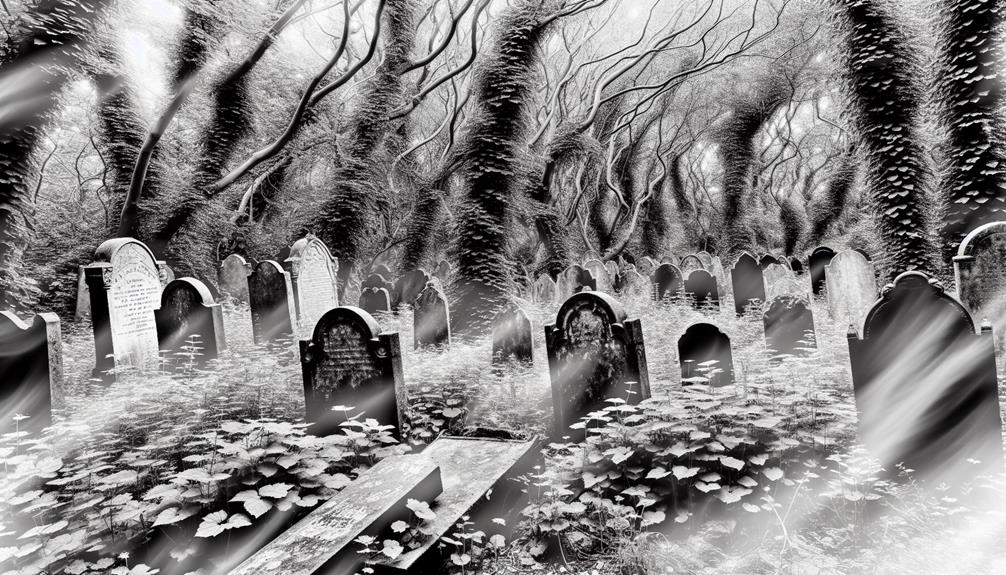Nestled in the French countryside, Oradour-sur-Glane's name evokes a sense of solemnity and reflection. The events that transpired on that fateful day in 1944 left an indelible mark on this village, forever changing its landscape and the lives of its inhabitants. Today, as visitors walk through the preserved ruins and silent streets, they are confronted with a stark reminder of the atrocities committed here. But what deeper lessons can be gleaned from this tragedy, and how does Oradour-sur-Glane continue to resonate with us in the present day?
Key Takeaways
- Oradour-sur-Glane was a village in France destroyed in 1944.
- Over 600 men, women, and children were massacred in the tragic event.
- The village remains preserved as a memorial to the lives lost.
- Visiting Oradour-sur-Glane offers a somber reminder of wartime atrocities.
- Lessons from Oradour-sur-Glane emphasize the importance of peace and remembrance.
History of Oradour-sur-Glane
The history of Oradour-sur-Glane is marked by a tragic event that took place during World War II, leaving a lasting impact on the village and its inhabitants. Prior to this event, Oradour-sur-Glane was a picturesque village in the Limousin region of central France, known for its quaint cobblestone streets and charming countryside. However, on June 10, 1944, the village fell victim to one of the most heinous war crimes committed by the Nazi Waffen-SS.
The aftermath of this atrocity left Oradour-sur-Glane in ruins, with the village almost entirely destroyed by fire. The once vibrant community was reduced to a ghost town, its buildings reduced to rubble and its streets haunted by the memories of the unspeakable violence that occurred on that fateful day. The scars of war crimes marred the landscape, serving as a stark reminder of the brutality and inhumanity of conflict.
The village ruins of Oradour-sur-Glane stand as a somber memorial to the innocent lives lost and a testimony to the horrors of war. The remains of the buildings, preserved in their destroyed state, serve as a poignant reminder of the atrocities committed during World War II. The preservation of Oradour-sur-Glane as a memorial site ensures that future generations will never forget the tragic events that unfolded in this peaceful village.
The Tragic Events of June 10, 1944
Marking a dark chapter in history, the events of June 10, 1944, in Oradour-sur-Glane reveal a harrowing tale of tragedy and brutality during World War II. On that fateful day, the village of Oradour-sur-Glane fell victim to unspeakable horrors that shook the world and left an indelible mark on the collective memory of humanity.
The following list aims to evoke emotions and provide insight into the gravity of the events that transpired:
- Innocent Lives Lost: Over 600 men, women, and children, including the elderly and infants, were mercilessly massacred by the German Waffen-SS troops.
- Unspeakable Acts of Violence: The village was methodically destroyed, with homes set ablaze and inhabitants herded into barns that were then set on fire, trapping and killing all inside.
- Families Torn Apart: The atrocity resulted in numerous families being torn apart, with many losing multiple members in the senseless violence.
- Impactful Remembrance: The tragic events of June 10, 1944, serve as a poignant reminder of the horrors of war and the importance of honoring the memory of the victims, ensuring that such atrocities are never repeated.
The historical significance of the events in Oradour-sur-Glane underscores the need for a world where freedom, peace, and humanity prevail over violence and oppression.
Visiting the Martyr Village Today
Visitors to Oradour-sur-Glane today can experience a somber and poignant journey through a preserved village that stands as a tribute to the tragic events of June 10, 1944. The village remains frozen in time, serving as a powerful reminder of the atrocities committed during World War II. Oradour-sur-Glane holds immense cultural significance, attracting tourists and historians alike to witness its historical preservation efforts and pay respects to the victims.
To enhance the understanding of the current restoration efforts and cultural significance of Oradour-sur-Glane, the following table provides a brief overview:
| Aspect | Details |
|---|---|
| Current Preservation | Ongoing efforts to maintain the village's structures and uphold historical accuracy. |
| Cultural Importance | Symbolizes the horrors of war and the importance of remembrance. |
| Visitor Experience | Guided tours offer insights into the village's history and the tragic events. |
| Memorial Center | Houses exhibits, artifacts, and testimonies to educate visitors about the past. |
| Impact on Visitors | Often described as a moving and emotional experience, fostering reflection. |
The meticulous preservation work and the conservation of Oradour-sur-Glane serve as a tribute to the resilience of the human spirit and the importance of honoring the memory of the innocent lives lost on that fateful day in 1944.
Preserving the Memory of Oradour
Preservation efforts at Oradour-sur-Glane encompass a multifaceted approach aimed at honoring the memory of the village's tragic past and ensuring its historical significance endures for future generations. The memory preservation and historical significance of Oradour are vital to understanding the impact of war and the importance of peace.
Here are four emotional aspects of the preservation efforts at Oradour-sur-Glane:
- Remembrance Walls: The walls of Oradour stand as silent witnesses to the horrors that transpired, bearing the scars of a painful history. They remind visitors of the atrocities committed and the lives lost, invoking a sense of solemn reflection.
- Memorial Plaques: Throughout the village, memorial plaques are placed to honor the memory of the victims and educate visitors about the events that unfolded on that fateful day. These plaques serve as poignant reminders of the human cost of war.
- Preserved Artifacts: Personal belongings and artifacts left behind by the villagers are carefully preserved, offering a tangible connection to the past. These items evoke strong emotions, serving as a testimony to the lives that were abruptly cut short.
- Eternal Flame: The eternal flame burning at the memorial center symbolizes hope and remembrance. It serves as a beacon of light in the darkness, honoring the memory of the victims and ensuring that their stories are never forgotten.
Oradour-sur-Glane Memorial Center
The Oradour-sur-Glane Memorial Center stands as a solemn reminder to the tragic events that unfolded in the village on that fateful day, preserving the memory of the lives lost and the horrors endured. This memorial center, located on the site of the former village, serves as a place of remembrance and reflection, honoring the victims of the massacre that took place during World War II.
Visitors to the Oradour-sur-Glane Memorial Center are met with a haunting display of the village's ruins left untouched since the atrocities of June 10, 1944. The preserved buildings, belongings, and even vehicles evoke a sense of the past, allowing visitors to connect with the history and tragedy of Oradour-sur-Glane.
One of the most impactful aspects of the memorial center is the inclusion of survivor stories. These firsthand accounts provide a personal and emotional insight into the events of that day, offering a glimpse into the suffering and resilience of those who lived through the massacre. Through these stories, visitors can better understand the human impact of war and the importance of remembrance.
In addition to survivor stories, the Oradour-sur-Glane Memorial Center houses exhibitions that delve into the historical context of the massacre, shedding light on the political and social circumstances that led to such a devastating event. Overall, the memorial center stands as a poignant tribute to the victims of Oradour-sur-Glane, ensuring that their memory will never be forgotten.
Lessons From Oradour-Sur-Glane
An examination of the events at Oradour-sur-Glane offers profound insights into the human cost of war and the enduring importance of historical remembrance. The village's tragic fate serves as a poignant reminder of the moral implications of conflict and the necessity of learning from past atrocities to prevent their recurrence. Here are four key lessons derived from the historical significance of Oradour-sur-Glane:
- Humanity's Capacity for Inhumanity: Oradour-sur-Glane illustrates how ordinary individuals can devolve into perpetrators of unspeakable horrors under the influence of wartime conditions, shedding light on the darkest aspects of human nature.
- Importance of Collective Memory: The preservation of sites like Oradour-sur-Glane is crucial in ensuring that the sacrifices made and the injustices suffered are not forgotten, emphasizing the duty of societies to uphold historical remembrance.
- Vigilance Against Extremism: By reflecting on the events at Oradour-sur-Glane, we are reminded of the dangers of extremism and the imperative to remain vigilant against ideologies that fuel hatred and division.
- Advocacy for Peace: Oradour-sur-Glane stands as a somber illustration of the devastating consequences of war, compelling us to work towards peaceful resolutions to conflicts and to foster a world where such atrocities are never repeated.
Frequently Asked Questions
How Has the Local Community Been Affected by the Events of 1944?
The local community's resilience and healing process have been deeply impacted by the events of 1944. Such traumatic experiences often shape collective memory, influencing social cohesion and individual well-being.
Community resilience can be observed through the ways in which individuals come together to support one another, rebuild trust, and find solace in shared narratives.
The healing process involves acknowledging the past, commemorating those lost, and fostering a sense of unity moving forward.
Are There Any Paranormal Activities Reported in Oradour-Sur-Glane?
Paranormal sightings and local legends often spark curiosity and intrigue among communities worldwide. Such reports can vary from ghostly apparitions to unexplained phenomena, contributing to the mystical lore of a place.
Locals may share stories of encounters with spirits or mysterious occurrences, adding layers of mystique to the area's history. These tales, whether rooted in fact or fiction, can shape the perception and identity of a region, enchanting both residents and visitors alike.
What Measures Are in Place to Prevent Similar Tragedies?
Lessons learned from past tragedies often lead to the implementation of preventative measures. These measures can include:
- Improved security protocols
- Increased awareness and training for authorities and the public
- Stricter regulations
- Enhanced emergency response plans
Can Visitors Explore the Ruins of Oradour-Sur-Glane Freely?
Visitor restrictions are in place to safeguard the preservation of historical sites. While some locations may allow free exploration, many implement guidelines to protect the integrity of the site.
Preservation efforts are often supported by limiting visitor access to specific areas or offering guided tours. This approach helps maintain historical significance while also fostering a respectful environment for memorial ceremonies and remembrance activities.
How Has the Landscape of Oradour-Sur-Glane Changed Over Time?
The landscape of a historical site like Oradour-sur-Glane may have evolved considerably over time due to various factors. Changes could be attributed to historical preservation efforts that aim to maintain the site's authenticity while accommodating urban development needs.
Additionally, environmental impacts, such as natural erosion or human interventions, may have influenced the site's appearance. Tourism growth could have also played a role in shaping the landscape to cater to visitor needs while preserving the site's historical significance.
Conclusion
To sum up, Oradour-sur-Glane stands as a chilling reminder of the atrocities of war, a scar etched into the fabric of history.
Like a silent sentinel, the village bears witness to the horrors of human cruelty, urging us to learn from the past and aspire for a future free from violence and injustice.
The memory of Oradour-sur-Glane serves as a beacon of remembrance, guiding us towards a world where peace and compassion reign supreme.


